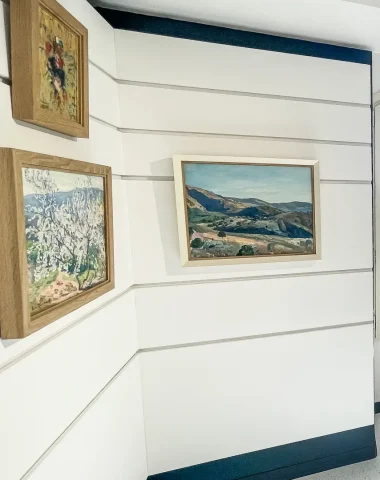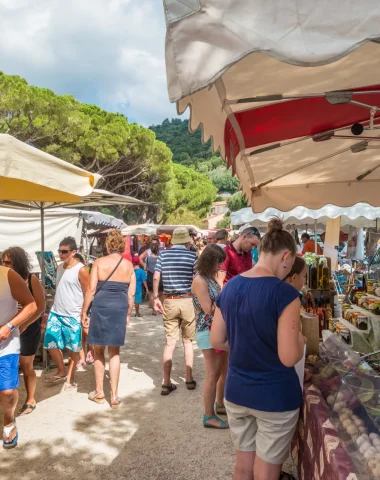Embark on a captivating journey along the Chemin des Sages, a project born from a visionary gathering of the Conseil des Sages, composed of wise individuals aged 60 and above, carefully chosen by local councilors for their wealth of experience. Inspired by the core principles of our Republican motto “Liberté, Égalité, Fraternité,” the council sought to breathe life into these ideals in the town of Bormes.
The Concept Takes Flight
A groundbreaking idea emerged during the council’s meeting—to adorn the town with phrases from renowned men and women, celebrated worldwide for their wisdom and humanism. The goal was to ignite the conscience of both passers-by and tourists, fostering a deeper connection with these universal values. To gain the support of the Mayor and the Council, the decision was made to integrate this pathway with the installation of historical plaques on the town’s iconic monuments. The members of the Conseil des Sages then meticulously designed the route through the medieval village and dedicated themselves to creating the perfect support, texts, images, and symbols for these plaques.

The butterfly, symbolizing joy, beauty, grace, and lightness of being, was chosen as the emblem of the project. Its transformative journey mirrors the essence of personal growth and rebirth. Just like the butterfly, we too experience different stages in life—a profound metamorphosis that allows us to release our past and embrace the beauty of who we’ve become. Symbolizing wisdom, the butterfly becomes a boundless source of inspiration. Beneath its delicate exterior lies an unwavering strength. Despite its ephemeral lifespan of a few days or weeks, the butterfly brings joy and exuberance through its graceful flight, fully savoring every moment that nature presents. Let us, like the butterfly, fearlessly embrace the experiences life offers us, both good and bad, knowing that they are fleeting. After all, our past experiences provide the best preparation for the future, allowing us to tread life’s paths with serenity.
Biography of Antoine de Saint-Exupéry
Ecrivain, poète, aviateur et reporter français, voix de la résistance.
Antoine de Saint-Exupéry, born on June 29, 1900, in Lyon, had a life filled with adventure and creativity, tragically cut short. Despite the early losses of his father and brother, he enjoyed a happy childhood as part of a noble French family. As a dreamy student, he completed his baccalauréat in 1917 and pursued studies in fine arts and architecture.

It was during his military service in 1922 that he discovered his passion for aviation and became a pilot. He joined the Latécoère company, which later became Aeropostale, transporting mail from Toulouse to Senegal. Alongside his flying career, he began his journey as a writer, penning novels such as “Courrier Sud” and “Vol de Nuit.”
Among his most celebrated literary works are “Le Petit Prince” (The Little Prince) from 1945 and “Terre des hommes” (Wind, Sand and Stars) from 1939, which received the prestigious Grand Prix de l’Académie française. As a pioneer of airmail, he crossed paths with aviation legends like Jean Mermoz and Henri Guillaumet. From 1932 onward, he combined his passion for aviation with journalism, embarking on notable reports from Indochina, Moscow, and Spain, which deepened his humanist values.
When World War II broke out, he served in the French Air Force, participating in reconnaissance missions. Following the armistice of June 1940, he traveled to New York with the mission of urging the United States to join the war, where he became an influential voice for the resistance movement. Seeking more direct involvement in the war effort, he joined a unit conducting photographic reconnaissance in preparation for the Provence landings in the spring of 1944.


Tragically, on July 31, 1944, Antoine de Saint-Exupéry disappeared at sea during a reconnaissance flight for Allied forces off the coast of Marseille. He was declared “dead for France.” In a poignant discovery, parts of his aircraft and a bracelet bearing his name were found on September 3, 2003, off the coast of Marseille.
One of his most famous literary works, “The Little Prince,” was written in New York during the Second World War and beautifully illustrated with his own watercolors. Originally published in 1943 in New York, it was posthumously published in France by Gallimard in 1946. The tale, both poetic and philosophical, follows the narrator, an aviator stranded in the Sahara, as he meets a little prince who contemplates the absurdities of the adult world.
The Bandstand
In 1948, the musical group La Renaissance had a simple request: they needed a dedicated space for musical performances, and it had to be appropriately fitted out. The Council granted their request, with the condition that the sidewalk should not be obstructed by a staircase leading to the rotunda. Thus, the little rotunda found its place on the rooftop terrace of the small PLM (Paris Lyon Méditerranée) bus office, where the group, formed in 1909, would soon showcase their talents.
Although the space was not originally intended for musical performances, it became a popular spot for various musical groups and a place for locals to rest, chat, exchange information, and share rumors. Its central location on the main access and commercial artery of the village made it a hub of activity.

As the Borméen musical group, La Renaissance, gained prominence, their numbers swelled to more than 30 different musicians by 1920. The original bandstand could no longer accommodate the entire group, and they preferred to perform in various village squares, notably at Place Gambetta. The band’s popularity grew alongside the village’s main annual event: the flower festival, later known as the Corso du Mimosa.
Over the years, the little rotunda stood witness to the confidences of thousands of people, becoming a cherished gathering spot. The image of its bougainvillea canopy has been captured in countless photographs, spreading the beauty of the place to far corners of the world.

To experience the full splendor of the Chemin des Sages and delve deeper into the fascinating stories that unfold along this path, we invite you to explore the Baludik app.
Scan the QR code and embark on an interactive journey filled with games, surprises, and a deeper connection to the rich heritage of Bormes.














